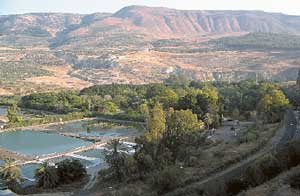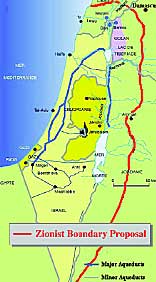Breaching Borders:
The Role of Water In The Middle East Conflict
By Isabelle Humphries
Washington Report on Middle East Affairs, September/October 2006, pages 20-21
Israel makes the most of water resources at the site of the destroyed village of Al Hamma in the occupied Syrian Golan Heights (Photo I. Humphries).IN MONTHS when Israel is not pounding the life out of its Lebanese neighbors, a tourist to Israel may hire a car and drive around the beautiful northern regions of former mandate Palestine and Syria. Here one may look around at the stunningly green surroundings, go kayaking in the Jordan River, admire the beautiful waterfalls at ancient Banyas in the Golan, or dip one’s feet in the waters of the Sea of the Galilee. Those feeling adventurous may hand over their passports at the gate, enter the Israeli-occupied Alawite village of Ghajar, and look down at the little stream of the Wazzani in the small valley below.
Israel has not ensconced itself in the Golan Heights for mere tourism opportunities, however. The Israeli media machine would have one believe that the country is engaged in a struggle to protect its very existence against imaginary Arab military giants. Yet a trip around the places in which it chooses to maintain its borders is far more revealing of the root of conflict with its Arab neighbors—water. Israel has no plans to make peace with Syria and return the Golan Heights, because by doing so it would give up its control of springs, rivers and the Sea of Galilee. Nor will it hand over any significant West Bank land to Palestinians, for in doing so Israel would have to abandon lush aquifers (underground water reserves), key access to the Dead Sea, the Jordan River, and surrounding fertile plains.
Division and distribution of a static resource such as land is difficult enough, but problems are magnified when the resource is able to flow across international boundaries. Take the Israeli furor over Lebanon’s installation of new pumping facilities on the Wazzani River in the fall of 2002. Despite the fact that the activity took place entirely on Lebanese land, Israel raised a ruckus because the Wazzani is a key tributary of the Hasbani River. And although the Hasbani flows for 25 miles inside Lebanon, it crosses into the Israeli-occupied Syrian Golan, feeding into the Banias and Dan Rivers, which in turn flow into the Jordan—ultimately providing water to the rapidly reducing Sea of Galilee, Israel’s largest source of fresh water.
While Beirut stated that it was Lebanon’s internationally recognized right to pump Wazzani waters for surrounding low-income Shi’i villages, Israel objected, claiming, as usual, that the “terrorist” entities of Syria and Hezbollah were behind the development plan. Lebanon retorted by pointing out that, even after pump installation, it would be taking only 10 million cubic meters annually—while Israel, on the other hand, uses some 150 million cubic meters a year from the Wazzani and Hasbani.
That particular episode of the water conflict did not erupt into full-scale war, but at other times water has provided the trigger. In his memoirs, Ariel Sharon claimed that the 1967 war (resulting in Israeli occupation of the Golan and prevention of Syrian access to the Sea of Galilee) was launched as an unavoidable response to Syrian attempts three years earlier to divert the headwaters of the Jordan.
The Historical Evidence
An analysis of historical evidence, however, provides a very different story of the events leading to the 1967 war. It was Israel, in fact, which first made moves to divert the headwaters, provoking an international crisis, yet convincing many that Syria was the aggressor. Israeli historian Avi Shlaim dates Israel’s first attempt to divert the Jordan River to as early as 1953, when Syria responded not by attacking the Jewish state, but complaining to the U.N., which eventually put a halt to the Israeli plan the following year. Ten years later however, Israel began to pump water from the Sea of Galilee into its National Water Carrier—a grave threat to vital Syrian, Lebanese and Jordanian water sources (see also Benny Morris). It was in response to this Israeli move that Syria planned to divert Jordan water into its own territory.
Remaining in control of the Golan Heights today allows Israel to irrigate settlements as far as the Negev desert through its National Water Carrier pipeline. The diversion of waters to this artificial carrier has grave implications, resulting in the depletion and salinization of the Jordan River south of the Sea of Galilee, and devastating agriculture on the Jordanian side of the river. The Jordanian government’s diversion of the Yarmuk cannot adequately compensate for this loss.
Israeli control of water is as much of a concern for Palestinians as it is for Arab neighbors. Whether for the few Palestinian farmers remaining inside the Israeli state, or those in the West Bank and Gaza, Israeli water policy is directed at destroying any remaining Palestinian agriculture. The million Palestinians inside Israel are primarily a flexible manual labor force for Jewish industry, as are—when curfews allow—1967 Palestinians. Even where Palestinians remain in control of small pieces of land, Israeli water policy usually sees to it that there is not enough water to grow crops.
Situated above the mountain aquifer, central West Bank towns such as Qalqilya and Nablus have traditionally exported crops across the Middle East. Yet today, despite the availability of sophisticated technology, Israeli policy means that many Palestinians do not have enough water even for themselves, let alone to irrigate the few fields that have not yet been confiscated.
Palestinians should have ready access to water from the mountain aquifer (divided into three), the Jordan River basin and the Gazan coastal aquifer. Aquifers are replenished through rainwater seeping through the ground, and water accessible via wells and springs. According to Oslo, two West Bank aquifers are to be shared between Israelis and Palestinians, leaving the Gazan coastal and the third West Bank aquifer solely to Palestinians. (Palestinians, of course, have no access to the Sea of Galilee—their share having been taken in 1948). According to Oslo, Syrians, Jordanians, Palestinians and Israelis all have a share in the Jordan River system (although 97 percent of the river passes through areas only occupied by Israel since 1967). Currently Israel has assured that its citizens have the highest per capita water consumption in the entire Middle East—and four times as much as the Palestinians among whom they live.
International law clearly states that Israel should not be taking water from areas occupied in 1967. Yet even if Oslo had been followed to the letter, it assured inequality by giving Israeli water authorities overall control of water resources. Palestinians may not drill for water without Israeli approval, yet Israel can pump as much water as it likes into its illegal settlements. More than 80 percent of West Bank water is taken by Israelis on both sides of the 1967 line.
Israeli occupation has prevented the development of a Palestinian water infrastructure which would make maximum use of the minimum resources. Some 200,000 West Bankers do not even have access to piped water systems, while the settlements around them are kept green with lawn sprinklers. Palestinians living under occupation are forced to rely on expensive private water tankers, which of course cannot reach them in times of closure. Ironically, some of the water is bought directly from Israelis at inflated prices, despite the fact that the water originates in the West Bank.
In contravention of Oslo, Israel continues to pump from the Gaza coastal aquifer—which, as levels fall dangerously low, draws in salt water from the Mediterranean. Two-thirds of water is used for the Israeli agricultural sector, which represents only 3 percent of Israel’s annual GDP, while the greater percentage of Palestinian farmers must rely on insufficient sources of rainwater for 90 percent of their agricultural activity. Desperate for water, Gazans also are overpumping this source, as their inadequate sewage networks continue to leak raw sewage into the supply. Medical sources in Gaza note an increase in kidney disease and other dangerous water-related illnesses. The U.N. estimates that in less than 15 years Gazans will not have access to drinkable water.
What little Palestinian water infrastructure there is falls regular victim to Israeli military assault. From the destruction of 140 wells in the 1967 war, to soldiers sniping at water tanks on family homes, to settlers vandalizing and polluting watercourses, to confiscation of wells for the building of “security” walls, Palestinians have no chance to improve their situation.
In July, Israel again launched a ground offensive into southern Lebanon. Is this another attempt to access the vital asset of the Litani River high on the agenda? (See box above.)
What is certain is that there will be no long-term security for any resident of the Middle East without fair distribution and a just solution to the sharing of water resources. Without regional cooperation on protecting rapidly depleting resources such as the Jordan River and the Dead Sea, not even Israel can count on secure water forever.
Isabelle Humphries is conducting Ph.D. research on the Palestinian refugee community inside Israel’s 1948 borders. She can be reached at <isabellebh2004@yahoo.co.uk>.
SIDEBAR
For Israel, Southern Lebanon Means the Litani River
When Chaim Weizmann and David Ben-Gurion attended the 1919 Paris Peace Conference ending World War I, they presented a map containing the boundaries of their hoped-for Jewish state. The map included what is now Lebanon’s Litani River (see top right of map).
Weizmann went on to become Israel’s first president, and Ben-Gurion its first prime minister, when that country was established in 1948. While the two had achieved great success in international geopolitics, they had failed to garner the Litani for Israel. The reason for their failure was the secret Sykes-Picot Treaty of 1915, under which Britain and France already had fixed the border between Lebanon and Palestine. At France’s insistence, Sykes-Picot was upheld at the Paris conference, and the Litani went to Lebanon.
Israel dubbed its March 14, 1978 invasion of southern Lebanon “Operation Litani,” with the stated objective of clearing out Palestinian Liberation Organization (PLO) bases south of the Litani River in order to secure northern Israel. Its 1982 invasion of Lebanon had the added goal of gaining access to the waters of the Litani. To end the Israeli siege of Beirut, the PLO was rapidly evacuated to Tunisia, and Israel eventually retreated from the Lebanese capital. Yet it never fully withdrew from southern Lebanon until 2000, under pressure from Hezbollah—and 22 years after being ordered to do so by U.N. Security Council Resolution 425.
Even after it withdrew, however, Israel remained determined to eventually seize the Litani River waters—as attested to by the Jewish state’s latest attempt to ethnically cleanse the land between the Litani and Israel’s northern border.
—Andrew I. Killgore
|
Races? Only one Human race United We Stand, Divided We Fall |
 |
No time to waste. Act now! Tomorrow it will be too late |
|



































